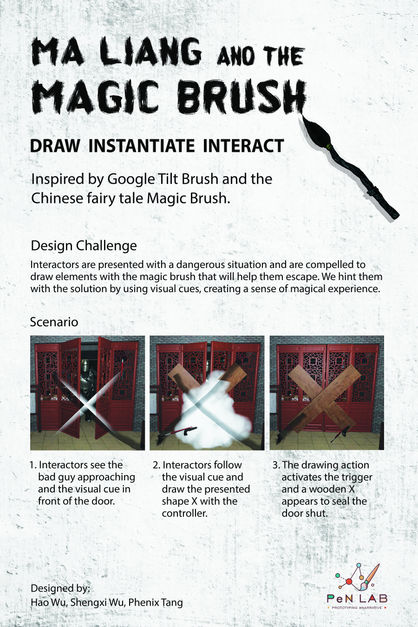Maliang & the Magic Brush
Game Introduction
Video game walkthrough
Summary:
Overview:
Maliang and the Magic Brush is a VR experiment designed for the HTC Vive and other room-scale VR devices. It was inspired by Google Tilt brush, a VR game that allows interactors to paint in an immersive 3D virtual space. Our team wants to take such experience even further by not only allowing interactors to paint in virtual space, but also being able to instantiate and interact with the objects they created in virtual space. We believe such instantiate experience could be best achieved in a VR environment and will bring dramatic agencies to our interactors.
Our narrative takes cues from an ancient Chinese traditional fairy tale "Magic Brush". The story was about a kind little boy Maliang. He had a brush with magic power that could turn anything he drew into real artifacts. While he was helping poor people with his magic brush, some bad guys wanted to take the brush away from him. Then Maliang would try to avoid being caught by those bad guys by using his magic brush.
Process:
-
Contextual Review & Defining Problem
-
Explore the high expectation of VR
-
Finding and analyze similar artifacts
-
-
Ideation
-
Brainstorming
-
Scene Design
-
Idea pitching for feedback
-
-
Repeating Prototyping
-
Storyboards
-
Building test version to get feedback
-
Iterating and completing the design
-
Draw, Instantiate and Interact
Virtual Reality is a media with extremely high expectation of experienced interactors and it has the potential to realize such expectation.
In our game, the dramatic moment is instantiating tangible objects by drawing.
However, drawing is a highly dependent behavior without certain fix convention. As long as the result of the interaction does not match the expectation of the interactions, frustrated could they be easily.
To constrain the expectation and results, our team decided to use visual cue (semi-transparent 3D symbol floating in the virtual space) to guide interactors. They need to find the cue, make sure what they drawn overlapped with the cues, then trigger the instantiation of an in-game objects and push the story.
We observed our testers' behavior, collect user feedbacks and conduct quantative/qualitative study on how to better design visual cues to constrain/motivate our interactors' behavior, which is the design challenge we identified for this project.




Challenge:
The biggest challenge we have is how to use the magic brush as a convention of interaction that constrains gestures, while motivating interactors with the unique power VR brings that is beyond ordinary experience. Currently our solution is to guide the interactors with visual cues, which are white outlines floats in the game environment that encourage interactors to paint on top of it. By doing this, interactors will be able to trigger events and proceed further in the game. During user testing, while some interactors are able to understand and follow the visual cues, many of them still need additional instructions on what to do next. This is because there is no convention for how to guide interactors' behavior in VR environment yet, our solution is somehow effective, but obviously not perfect. If time permits, our next step is to further explore what would be a better way to visually or auditorily guide interactor’s behavior in a VR narrative.




